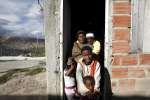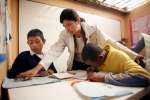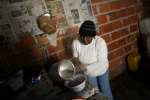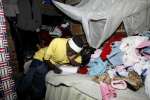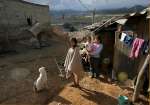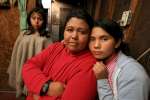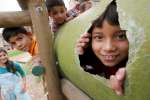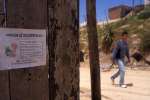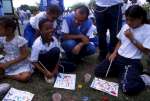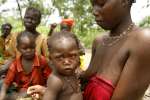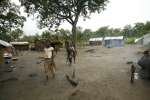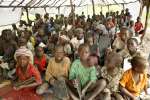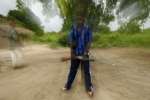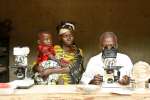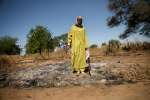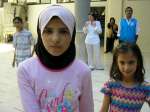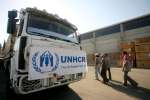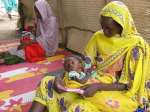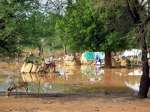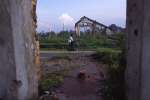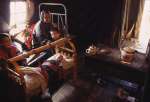Home > Who We Help > Internally Displaced People > IDPs: Photo Galleries
IDPs: Photo Galleries
Education for Displaced Colombians
UNHCR works with the government of Colombia to address the needs of children displaced by violence.
Two million people are listed on Colombia's National Register for Displaced People. About half of them are under the age of 18, and, according to the Ministry of Education, only half of these are enrolled in school.
Even before displacement, Colombian children attending school in high-risk areas face danger from land mines, attacks by armed groups and forced recruitment outside of schools. Once displaced, children often lose an entire academic year. In addition, the trauma of losing one's home and witnessing extreme violence often remain unaddressed, affecting the child's potential to learn. Increased poverty brought on by displacement usually means that children must work to help support the family, making school impossible.
UNHCR supports the government's response to the educational crisis of displaced children, which includes local interventions in high-risk areas, rebuilding damaged schools, providing school supplies and supporting local teachers' organizations. UNHCR consults with the Ministry of Education to ensure the needs of displaced children are known and planned for. It also focuses on the educational needs of ethnic minorities such as the Afro-Colombians and indigenous people.
UNHCR's ninemillion campaign aims to provide a healthy and safe learning environment for nine million refugee children by 2010.
Colombia: Life in the Barrios
After more than forty years of internal armed conflict, Colombia has one of the largest populations of internally displaced persons (IDPs) in the world. Well over two million people have been forced to flee their homes; many of them have left remote rural areas to take refuge in the relative safety of the cities.
Displaced families often end up living in slum areas on the outskirts of the big cities, where they lack even the most basic services. Just outside Bogota, tens of thousands of displaced people live in the shantytowns of Altos de Cazuca and Altos de Florida, with little access to health, education or decent housing. Security is a problem too, with irregular armed groups and gangs controlling the shantytowns, often targeting young people.
UNHCR is working with the authorities in ten locations across Colombia to ensure that the rights of internally displaced people are fully respected – including the rights to basic services, health and education, as well as security.
Colombia: Assisting the Internally Displaced
Colombia is the worst humanitarian crisis in the western hemisphere. More than two million people have been internally displaced during the conflict, including 200,000 persons in 2002 alone. Tens of thousands of other Colombians have sought refuge abroad.
UNHCR provides legal assistance to these internally displaced persons (IDPs), supports their associations and on the national level has helped to strengthen government programmes and relevant legislation. Specialised agency programmes include education, psychological and social rehabilitation projects for children and their families and assistance to women who head households.
Crisis in the Central African Republic
Little has been reported about the humanitarian crisis in the northern part of the Central African Republic (CAR), where at least 295,000 people have been forced out of their homes since mid-2005. An estimated 197,000 are internally displaced, while 98,000 have fled to Chad, Cameroon or Sudan. They are the victims of fighting between rebel groups and government forces.
Many of the internally displaced live in the bush close to their villages. They build shelters from hay, grow vegetables and even start bush schools for their children. But access to clean water and health care remains a huge problem. Many children suffer from diarrhoea and malaria but their parents are too scared to take them to hospitals or clinics for treatment.
Cattle herders in northern CAR are menaced by the zaraguina, bandits who kidnap children for ransom. The villagers must sell off their livestock to pay.
Posted on 21 February 2008
Internally Displaced in Chad
In scenes of devastation similar to the carnage across the border in Darfur, some 20 villages in eastern Chad have been attacked, looted, burned and emptied by roving armed groups since 4 November. Hundreds of people have been killed, many more wounded and at least 15,000 displaced from their homes.
Some 7,000 people have gathered near Goz Beida town, seeking shelter under trees or wherever they can find it. As soon as security permits, UNHCR will distribute relief items. The UN refugee agency has already provided newly arrived IDPs at Habila camp with plastic sheeting, mats, blankets and medicine. The agency is scouting for a temporary site for the new arrivals and in the meantime will increase the number of water points in Habila camp.
The deteriorating security situation in the region and the effect it might have on UNHCR's operation to help the refugees and displaced people, is of extreme concern. There are 90,000 displaced people in Chad, as well as 218,000 refugees from Darfur in 12 camps in eastern Chad.
Posted on 30 November 2006
Displaced Lebanese in Syria: Emergency Relief Supplies Arrive
A humanitarian convoy, loaded with emergency relief supplies from UNHCR's regional stockpile in Amman, Jordan, arrived in Damascus this week. Part of the shipment of mattresses, blankets, kitchen sets, soap and cooking stoves will be distributed to Lebanese refugees and asylum seekers in Syria while the rest will be trucked to Lebanon to help some 100,000 internally displaced living in community shelters and with host families.
In Syria this week, UNHCR distributed 6,544 mattresses, with the bulk going to Homs in the north, where we estimate 20,000 Lebanese are sheltering. UNHCR Syria has started distributing locally procured relief items including 3,300 pillows, bed linen, some 67,000 pieces of underwear and 6,400 diapers to host families and Lebanese in need.
Since the conflict began a month ago, some 160,000 Lebanese have fled across the border into Syria, with 1,500 now arriving daily. Most Lebanese are staying with Syrian host families or in schools, summer camps, community centres, mosques and hotels. While local generosity has been overwhelming, it is in danger of being overstretched.
Posted on 14 August 2006
Destruction and Displacement in Darfur, Sudan
An estimated one million people have been displaced within Sudan's western region of Darfur by fighting that erupted in early 2003. Militia have reportedly killed and raped villagers and forced hundreds of thousands from their homes in Darfur.
Many of the displaced people are living in squalid, makeshift encampments, where they continue to fear attacks by marauding militia.
UNHCR became operational in Darfur in June 2004 following a request from the UN country team for the refugee agency to share its expertise in protection, camp management and site planning. UNHCR has opened offices in Nyala and El Geneina and plans to establish a presence in El Fasher. UNHCR teams have begun evaluating existing camps for displaced persons to improve the layout and design and have begun training governmental camp managers in protection and the rights of displaced people.
Sri Lanka: IDPs and Returnees
During Sri Lanka's 20-year civil war more than 1 million people were uprooted from their homes or forced to flee, often repeatedly. Many found shelter in UNHCR-supported Open Relief Centers, in government welfare centers or with relatives and friends.
In February 2002, the Sri Lankan government and the Liberation Tigers of Tamil Eelam (LTTE) signed a cease-fire accord and began a series of talks aimed at negotiating a lasting peace. By late 2003, more than 300,000 internally displaced persons had returned to their often destroyed towns and villages.
In the midst of these returns, UNHCR provided physical and legal protection to war affected civilians – along with financing a range of special projects to provide new temporary shelter, health and sanitation facilities, various community services, and quick and cheap income generation projects.
Ingushetia: Internally Displaced Chechens
When fighting broke out between government troops and rebel forces in Chechnya in 1999, over 200,000 people fled the republic, most of them to the neighbouring republic of Ingushetia. Today, tens of thousands of Chechens remain displaced in Ingushetia, unwilling to go home because of continuing security concerns.
As of early December 2003, some 62,000 displaced Chechens were living in temporary settlements or in private accommodation. Those living in settlements face constant threats of eviction, often by owners who wish to use their buildings again.
Another 7,900 displaced Chechens live in tents in three remaining camps – Satsita, Sputnik, and Bart.
The authorities have repeatedly called for the closure of tent camps and the return of the displaced people to Chechnya. Three camps have been closed in the past year – Iman camp at Aki Yurt, "Bella" or B camp, and "Alina" or A camp. Chechens from the latter two camps who did not wish to go home were allowed to move to Satsita camp or other existing temporary settlements in Ingushetia.

